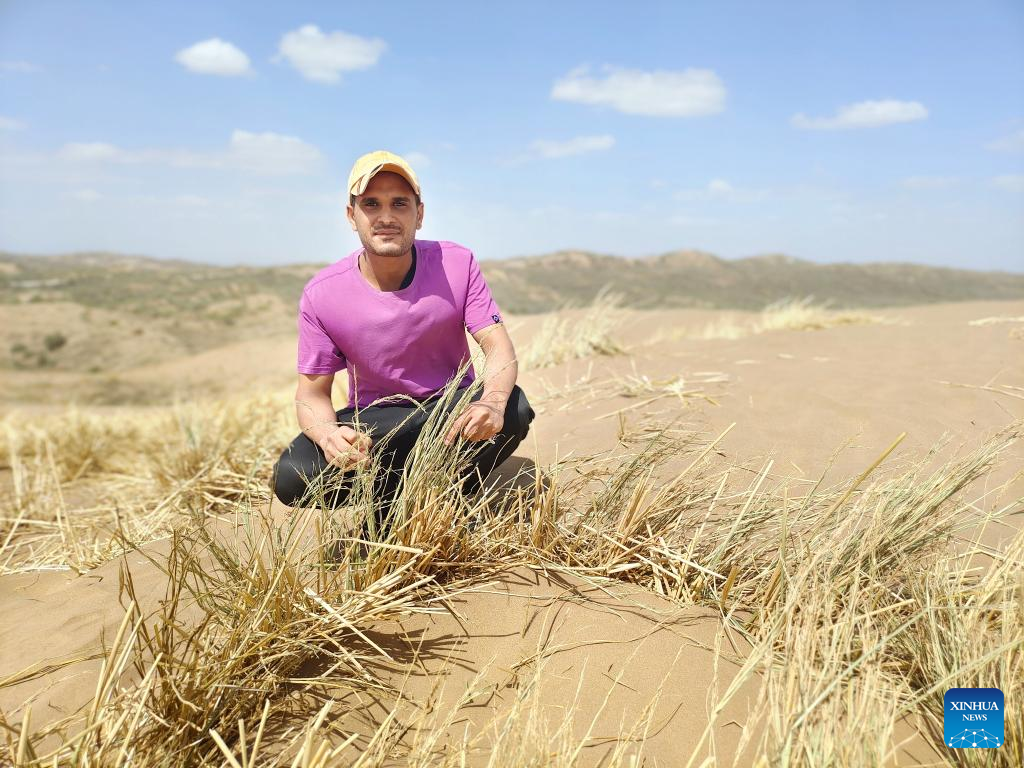
Mohammed Abdulkarem from Yemen poses for a photo with a grass grid he made in northwest China's Ningxia Hui Autonomous Region, June 16, 2023. (Xinhua/Xie Jianwen)
YINCHUAN, June 17 (Xinhua) -- Standing on top of a sand dune, Mohammed Abdulkarem from Yemen overlooked a green belt in the Baijitan national nature reserve in northwest China's Ningxia Hui Autonomous Region and marveled at China's efforts to combat desertification.
"It's hard to believe the oasis right down there used to be a desert. As a country in the Arabian Peninsula, my country also needs to protect people from threats of desertification, and I saw good examples here," said the 29-year-old.
The World Day to Combat Desertification and Drought falls on Saturday. The Ningxia Medical University organized a tour on Friday to mark the day, inviting about 30 international students to visit Baijitan.
Feeling sand and dust picked up by the hot summer wind blowing on their face, Abdulkarem and his schoolmates from countries including Thailand, Zimbabwe, and Pakistan were told that the 60-km-long and 30-km-wide man-made forest in Baijitan plays a function of blocking windblown sand from Maowusu, one of China's major deserts. The oasis, however, was once a barren land known for "no birds in the sky and no grass on the ground" back in the 1950s.
Over the past 70 years, with the unremitting efforts by local people and volunteers, 680,000 mu (45,333 hectares) of trees have been planted, raising the local forest coverage rate to 41 percent. The afforestation has curbed the expansion of the Maowusu Desert and has become a miracle in the history of sand control in the world.
"Anti-desertification is always a global theme, and we want to highlight the significance of ecological protection to our students," said Shan Bin, head of the university's school of international education. "We also want them to know China's resolutions and contributions in building a beautiful earth for all human beings."
With help and instructions from local professionals, Abdulkarem still felt it hard to make a straw checkerboard, which is a local method to prevent the sand from moving.
"It's really strenuous and challenging, and I'm quite encouraged by the spirit of sand controlling year after year. I'd never known that straws could be used to fix sand, which is cheap and works really well," he said.
Rueang Ngam Namrin, 27, from Thailand, was not familiar with blowing sand and dust in a desert.
"If we don't preserve this land, the sand will be blown to threaten cities and rivers," she said. "It's complicated and new for me, and I didn't know that deserts could be so harmful."
The students also visited the Museum of Baijitan, which records the history of how locals conquered desertification and preserved the ecosystem. The reserve is now home to 311 species of wild plants and 129 species of wild animals, according to the latest data.
"This trip is really rewarding. I see the great effort China has made to protect our planet, and it's worth the world learning," said Davis Munashe from Zimbabwe, who took many pictures along the tour. ■



